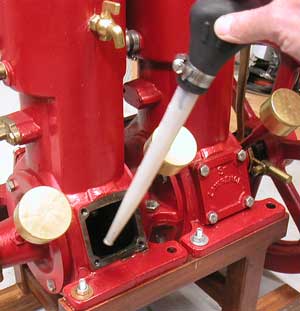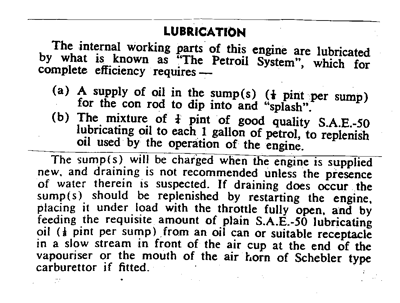|
| Oil/gas in two-cycle engine crankcase |
| Author |
Message |
    
barry
Member
Username: barry
Post Number: 20
Registered: 02-2006
| | Posted on Saturday, October 21, 2006 - 02:19 pm: | 




|
I’ve read and heard that build up of oil/gas in the crankcase of an old two-cycle engine makes it difficult to start the engine. I would appreciate more information about this and if possible an explanation to explain why this build up occurs and why this build up causes starting difficulty. |
    
richardday
Senior Member
Username: richardday
Post Number: 408
Registered: 11-2003

| | Posted on Saturday, October 21, 2006 - 04:25 pm: | 




|
I cannot answer the why oil build up causes difficult starting but I can tell you that many makers shipped a petcock wired to the engine intended to be installed in the bottom of the crankcase. It was a common practice for boat builders to pipe the crankcase drain outside the engine bed timbers so the drain pet cock could be reached easily. The drain was also needed if the engine crankcase got flooded with water. Bilge water flooding with the two port two stroke was particularly easy with the mixer or carbuetor so low in the engine.
Excessive gas as distinct from oil build up meant a badly flooded engine and two strokes are notoriously finicki regarding the air/fuel mixture. Presumably opening the drain would remove any liquid fuel in the bottom of the crankcase. A common practice for starting a two stroke that is slightly flooded is to open the priming cup cranking the engine over until you get a firing. Close the priming cup and the engine should start on the next attempt to pull the flywheel over. Read "TIPS" |
    
barry
Member
Username: barry
Post Number: 21
Registered: 02-2006
| | Posted on Sunday, October 22, 2006 - 12:39 pm: | 




|
Richard,
Thanks for your informative comments.
Firstly regarding the build up of gas/oil mixture in a two-cycle engine crankcase, I believe this must be related to fundamental two-cycle principles.
Assuming an engine is operating at maximum speed, carburetor needle is at optimum adjustment, throttle plate is full open, then the amount of fuel entering the crankcase is dependent upon crankcase vacuum and crankcase volume, inlet port size, and in the case of a two port, check valve cracking pressure. On the other hand, fuel entering the combustion chamber is dependent upon crankcase pressure, combustion chamber pressure, by pass and transfer port characteristics.
The quantity of fuel entering the crankcase is not necessarily the same amount that is transferred to the combustion chamber. Maybe surplus fuel liquefies and mixes with grease from the main bearings and deposits as sludge in the bottom of the crankcase. This sludge occupies crankcase volume and as a result the amount of fuel entering the crankcase becomes less as the sludge volume increases until equilibrium is achieved. Then fuel entering and leaving the crankcase is the same. Sludge volume would then remain at a constant level.
In my September 23 post in the Test Bench thread, I reported a rapid crankcase build-up, in one test 30 cc (almost 2 cubic inches) in 30 minutes. Of course if build up continued at this rate, the crankcase would soon become filled which of course does not happen. Using an identical engine in my boat, I only empty the crankcase at the end on season so this seems to support the equilibrium theory.
My engines do not have a drain plug so I use a vacuum bulb ( cake baster) via the access plate, image attached.
Modern two cycle engines used with weed whackers, chain saws etc must have a finely tuned crankcase volume as apparently crankcase build up is not an issue.
Regarding the second concern that sludge build up causes difficult starting, I believe that this may be caused by build up in excess of the equilibrium amount due to excessive priming or external factors that result in less fuel available for transfer to the combustion chamber.
All of the above is supposition so will appreciate other opinions.
Barry
 |
    
jb_castagnos
Senior Member
Username: jb_castagnos
Post Number: 189
Registered: 07-2002

| | Posted on Sunday, October 22, 2006 - 08:43 pm: | 




|
I think the biggest cause of crankcse buildup is poor atomization of fuel, cold crankcases allowing condensation of fuel, and oil mixed with fuel that won't vaporize. The biggest starting problem I've seen with this is engine flooding as the crankcase warms up. After riding slow for a while at shows I have to head out to open waters and open it up to clear it out,it'll run rich for a minute, leaning will smooth it out until the case clears then it will go lean. Guess I could use the case drains on mine. I think once the level gets into the crank and rod it stirs it up enough that it's pulled into the intake. Most modern engines have little space in the crankcase, run at higher speeds, and on the aircooled engines the case gets hot. |
    
johnny
Senior Member
Username: johnny
Post Number: 52
Registered: 03-2006
| | Posted on Friday, November 17, 2006 - 08:26 am: | 




|
Just thought I would let you know that I have run into this same problem on stationary two cycle Detroits. Sometimes the engine would not want to start, open the brass valve on the bottom of crank case and drain the excess liquid and engine starts. This is a low pressure fuel injected engine. |
    
pauldfixr
New member
Username: pauldfixr
Post Number: 1
Registered: 09-2006
| | Posted on Saturday, November 18, 2006 - 06:23 pm: | 




|
On two-cylinder Chrysler outboards, there is a system intended to automatically take the 'pooled' fuel/oil mixture in each crankcase and transfer it to an atomization port in the 'other' one. I've seen this on the 9.9-15 and the 20-25HP engines, doubtless it is designed into all their 2 cylinder engines. Proper tuning of these engines requires that the system reach 'equilibrium' by operating for a period of time before final fine tuning is attempted.
I never fully appreciated the 'transfer port' system until reading this thread! Thanks! |
    
barry
Member
Username: barry
Post Number: 25
Registered: 02-2006
| | Posted on Sunday, November 19, 2006 - 04:44 pm: | 




|
Thanks for replying and providing very useful information. Maybe it will yet be possible to solve these mysteries.
Mystery 1 - Why does oil/ gas / grease /sludge collect in the crankcase of an old two-cycle engine, the quantity appears to reach a level then does not increase?
Mystery 2 - Why does the presence of this sludge in some cases makes starting very difficult whereas in other cases the presence of sludge does not influence engine starting?
Mr. Castagnos regarding your very relevant observations, is it possible that the air /fuel ratio change that occurs during slow speed operation at shows has to do with the method used to reduce engine speed. One way to reduce engine RPM is to retard ignition, the other to maintain advanced ignition and close throttle disk. I know that is common practice to leave the throttle disk ( Schebler D) full open and retard ignition to reduce RPM as this is often more convenient. In my opinion, this is ok for a short time such as during docking but not for continuous operation at low speed as it will eventually result in too rich a mixture, rough operation, fuel waste, possible flooding. I hold the view that, a two- cycle engine operates best, with most efficient use of fuel when ignition is advanced, and carburetor throttle disk is closed to set desired engine speed.
I usually operate the one cylinder St Lawrence in my boat at maximum RPM, 860 RPM
( prop is 12”D x 14”P). I close the Schebler throttle disc to a position where any more closing would slow the engine. This is about half position for my engine. I also use a Tiny Tach so am able to easily achieve this setting as I have this instant RPM readout. When I slow the engine, I first close the throttle disk before retarding ignition.
I think it possible that this may be related to Mystery 2 so your comments re above will be valuable.
Johnny, when you experience starting difficulty that requires the crankcase to be drained, does this occur after having operated your engine at slow speed with ignition retarded?
Paul, can you provide more detail and whether this is standard practice with all 2-cycle outboard engines, not just Chrysler. How is crankcase build up handled with a single cylinder engine?
Barry |
    
johnny
Senior Member
Username: johnny
Post Number: 53
Registered: 03-2006
| | Posted on Sunday, November 19, 2006 - 07:22 pm: | 




|
Barry,
You are correct about running the engine at slow speed and the ignition retarded. It will run this away for a good while then evently will shut off. This is when it sometimes does not want to start until you drain the crank case. I would guess that this might not happen if the engine was run at regular operating speed and under a load. Remember this is on my stationary engine with no load. Also uses dual drip oiler for lubrication of the piston, sleeve upper con rod and the lower con rod. grease lubricates the mains. |
    
jb_castagnos
Senior Member
Username: jb_castagnos
Post Number: 200
Registered: 07-2002

| | Posted on Sunday, November 19, 2006 - 09:51 pm: | 




|
Closing the throttle will probably help, the air rushing through the throttle plate would help atomize the mixture. The Schebler is a poor carb design, there's no venturi and no idle circuit. On my Holiday 4cycle, I close the throttle and retard the timing. It runs very slow, but when stopped fuel rushes from the carb. I think it's running on the vapors of a puddle of gas in the throat and when it loses the airflow it drains. |
    
ernie
Senior Member
Username: ernie
Post Number: 511
Registered: 01-2002

| | Posted on Monday, November 20, 2006 - 10:35 am: | 




|
All of the above is true. However I think it is related to airfuel mixture flow in the engine. I have some engines that require draining frequently. I have a Hawboldt 5 hp that ran for both days at the Mystic Seaport show last summer and collected NO fuel/oil in the base. It was running at less than 100 RPM during this time. Carb open a little and the timeing really retarded.
My Brown an Talbot needed draining at least 4 or 5 times in the same situation.
The Hawboldt is a 3 port, the Brown and Talbot is a 2 port.
As to the cmment on crankcase drains on outboards OMC has used them for years. Some went back into the intake or transfer port and some just went into the exhaust. |
    
barry
Advanced Member
Username: barry
Post Number: 43
Registered: 02-2006
| | Posted on Thursday, February 22, 2007 - 07:46 pm: | 




|
A thread was started Feb 06 in the Blaxland section titled Fuel Mix. Several post referred to the Blaxland manual stating --- the sump will be charged with oil at the factory prior to shipping and oil was to be replenished if draining is required.
http://www.oldmarineengine.com/discus/messages/3452/101555.html
Blaxlands are typical three port two stroke engines.
Garry Edwards from Sydney sent me a copy of the Blaxland manual.I am attaching a copy of the oil in sump information contained in the manual.
I find this baffling. I intend to try this when the weather warms.
Barry
}} |
|
|
|


|


